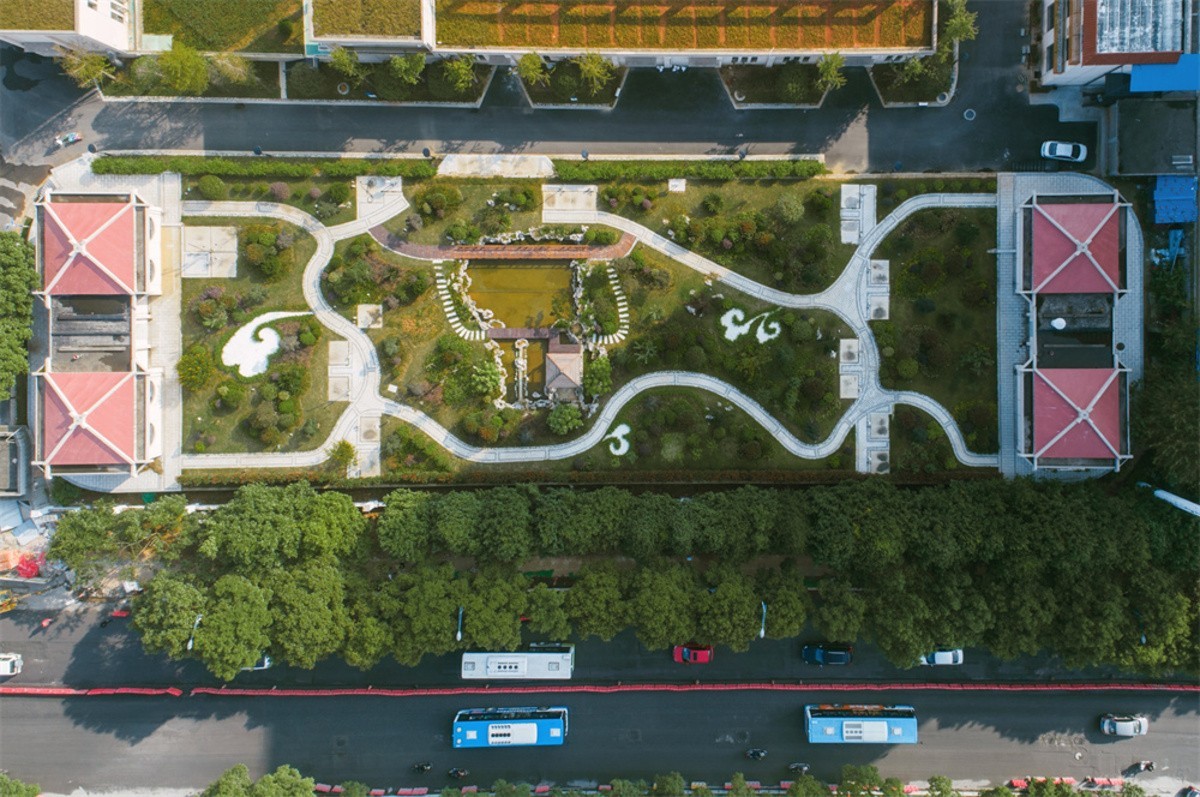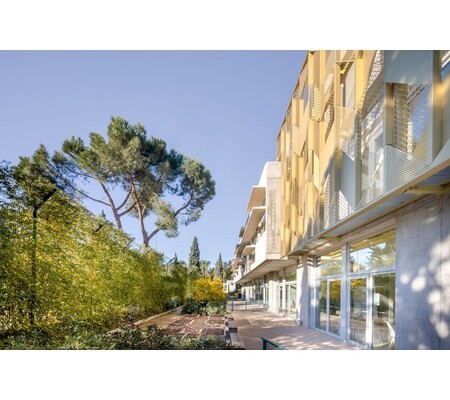Changsha Xianghu wastewater treatment plant upgrading reconstruction and reclaimed water reuse demonstration project
Last modified by the author on 25/03/2023 - 13:58
- Year of commitment : 2016
- Address 1 - street : 芙蓉区车站北路140号 410000 长沙市, 中国
- CO2 Impact : Reduce CO2 4734.4 tons/year
- Water cycle : Used Water, Purification, Used water recycling
-
299 777 600 欧元
- Builder
CECEP Guozhen Environmental Protection Technology Co., Ltd. - Manager / Dealer
CECEP Guozhen Environmental Protection Technology Co., Ltd.
Changsha Xianghu wastewater treatment plant (WWTP) was designed in 1992 and put into operation in June 1994. The design flow rate was 14 × 104 m3/d, covering an area of 52.5 acres, located in the east of South Station Road and the south of Evening News Avenue. The project was upgraded at the original site with a total investment of 299 million yuan. The sewage treatment adopted the process of pretreatment + A2O + MBR (membrane bioreactor) + contact disinfection, and the sludge treatment adopted the mechanical centrifugal concentration dehydration process. The effluent water quality was improved from the first level B to the surface water environmental quality standard (GB3838-2002) Class IV (TN ≤ 8mg / L), and the effluent was reused as the water supply for the autumn and winter dry season of Changsha Martyrs Park. In order to effectively protect the water quality of Liuyang River, implement energy conservation and emission reduction, and promote the reuse of reclaimed water in Changsha City, it was simultaneously realized of the upgrading to meet the new standards, effluent water reuse, deodorization and noise reduction, and landscape optimization in the design stage. The design features are as follows:
1. This project was the first large-scale (140,000 m3/d) reclaimed water reuse project with high water quality (quasi-surface IV standard, TN ≤ 8) in Hunan Province. After advanced treatment, the effluent can be selectively reused as the water supply for the autumn and winter dry season of Nianjia Lake and Yuejin Lake in Changsha Martyrs Park. The implementation of this project will partially achieve the goal set in the Changsha Urban Reclaimed Water Utilization Plan and greatly reduce the dependence of the two lakes on tap water supply in autumn and winter.
2. In order to save land, the advanced and reasonable MBR process was selected, and the integrated design was adopted. The plant was updated to meet new standards on a very limited footprint.
3. This project has carried out a full range of deodorization and noise reduction in Xianghu WWTP, adopted comprehensive technical measures, and actively explored the process route of noise reduction and deodorization in city center WWTP.
4. This project took Xianghu WWTP as a model for the transformation of city center WWTP, built it into a green WWTP and leisure attraction, and fully demonstrated the design concept of green municipal engineering.
5. Xianghu WWTP was designed according to the high standard requirements of intelligent water affairs in terms of automatic control. The main contents of intelligent water design include: expert database, intelligent management, water quality monitoring and early warning and visual system.
6. The land use of this project was extremely tight, the surrounding conditions were complex, and the water quality standards were strict. It had a wide demonstration effect on similar projects in the province.
7.The project had reasonable effluent quality setting, advanced process route, compact general layout, reasonable and economical total investment estimation, and low operating cost, which provided a new choice and reference method and experience for similar projects in Hunan Province.
Data Reliability
Self-declared
Sustainable Development
Testimony / Feedback
This project was the first high-quality ( quasi-surface class IV standard, TN ≤ 8 ), large-scale ( 140,000 m3 / d ) reclaimed water reuse project in Hunan Province. Under the background of extremely limited land use, sensitive surrounding environment and strict effluent requirements, the project simultaneously realized the upgrading and reconstruction of the plant area, tail water regeneration and reuse, full-field deodorization and noise reduction, and overall landscape optimization. The whole life cycle concept was implemented in the design process. By utilizing the MBR, Biowin and other new technologies, the project had fully realized land saving, energy saving, water saving and material saving. At the same time, the project also provided new choices and methods and experiences worthy of reference for similar projects in our province. It had a wide range of demonstration and promotion value, fully embodied the green municipal design concept of ' green, recycling and low carbon ', and constructed an innovative, optimized, environmentally friendly and ecologically beautiful new ' green ' modern sewage treatment plant.
Governance
CECEP Guozhen Environmental Protection Technology Co., Ltd.
Public Local Firm
CECEP Guozhen Environmental Protection Technology Co., Ltd.
Other
CECEP Guozhen Environmental Protection Technology Co., Ltd.
Public
(1) Project construction
The two sets of sewage treatment systems in the north and south were reformed step by step. Different working surfaces were constructed at the same time, and the professional cross-operation method was adopted. Firstly, the sewage system on the south side was implemented. After that, the construction of the north side system was started. At the same time, the equipment on the south side was installed and debugged. During the construction of the project, the production plan of limiting production + stopping production + limiting production was adopted to minimize the social impact of the shutdown of the sewage treatment plant.
(2) Operation management
1. Establish and improve the production management organization. 2. Carry out the necessary qualification examination for the employees. 3. Organize the professional and technical training of operators before they go to work. 4. Hire experienced professional and technical personnel responsible for the technical management of the factory. 5. Select professional and technical personnel for technical training. 6. Establish and improve the factory management rules and regulations, including job responsibility system and safety operation procedures. 7. Regular assessment of employees and the implementation of reward and punishment system. 8. Organize professional and technical personnel to enter the post in advance, participate in the whole process of construction, installation, commissioning and acceptance, and lay the foundation for future operation. 9. Organization to participate in the national sewage treatment industry technical information network activities.
BOT
Sustainable Solutions
- Provide experience for upgrading and reconstruction of WWTP

Changsha Xianghu WWTP was designed in 1992. The effluent quality met the first level B standard of Discharge Standard of Pollutants for Wastewater Treatment Plant (GB 18918-2002). The effluent flows into Liuyang River and then into Xiangjiang River. With the completion of the Xiangjiang Changsha comprehensive hub, the self-purification capacity of the Xiangjiang Changsha section had decreased, which had posed a serious threat to the safety of drinking water in the Changsha-Zhuzhou-Xiangtan reservoir area. Therefore, the Xianghu WWTP was in urgent need of upgrading. In this project, the AAO + MBR process was selected as the upgrading and reconstruction process of Changsha Xianghu WWTP. The effluent quality was excellent and met the quasi-IV standard of Surface Water Environmental Quality Standard (GB 3838-2002), which could be directly reused. Based on the activated sludge-anaerobic digestion (ASDM) kinetic model, the Biowin software was used to simulate the whole process repeatedly in the early stage of the design. Finally, the process conditions and operating parameters that can not only meet the standard stably, but also save the power consumption and chemical agent consumption, and the optimization design was completed accordingly.
(2) Provide a method for the construction of urban sewage treatment plant
Xianghu WWTP was built in the suburbs, surrounded by fish ponds, wasteland, etc. With the development of the city, the surrounding area of the plant had become a high-rise urban commercial and residential area, led to a shortage of land for this project. In order to effectively utilize the site, the original buildings and structures in the plant were firstly retained as far as possible during the design process. The new MBR structures integrated the aerobic tank, membrane tank, blower room, pump room, equipment room, dosing room, power distribution room and other functions, and carried out a fully integrated design. At the same time, the odor and noise pollution control measures were further strengthened to avoid the impact on the surrounding environment.

Photo credit
Hunan Architectural Design Institute Group Co., Ltd.






















